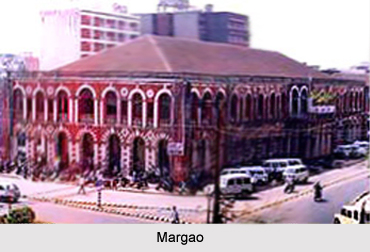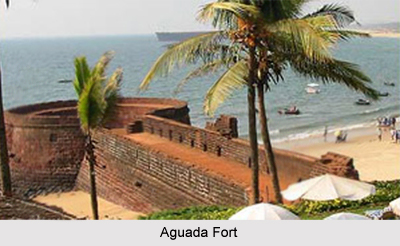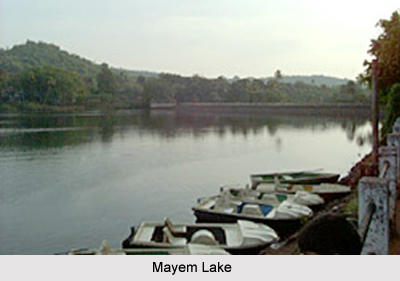 The district of north Goa is full of tourist places as it has beaches, temples, churches, museums, art galleries, gardens, peaks and many more which are an essential feature to become a perfect tourist spot.Some of the important places, which are regarded as the tourists` spots can be mentioned as follows:
The district of north Goa is full of tourist places as it has beaches, temples, churches, museums, art galleries, gardens, peaks and many more which are an essential feature to become a perfect tourist spot.Some of the important places, which are regarded as the tourists` spots can be mentioned as follows:
Panaji: this is the capital of Goa and also the headquarters of North Goa District. This is basically a small and charming city on the left bank of silvery Mandovi River. The beautiful red-roofed houses are seen in abundance in the city. These houses are built in Latin style. This district can also boasts of many modern houses, well laid gardens, statues and avenues lined with Gulmohar, Acassia and other trees. The enthralling scenic beauty can be found when it is viewed from atop Altinho or from the hilltop.
Mapusa: This is situated at 13kms from the district headquarters. This place is the capital of Bardez Taluka, which is on the NH 17. It is at the cross roads of the network of highways covering whole of North Goa. There is weekly fair, which is celebrated on Friday and is held at the modern streamline market. A large crowd usually comes to attend the market and enjoy a lot at that place.
Pilar: This is placed at the distance of 11 Km from district headquarters. This is an important religious and educational centre of Christian Missionaries as well. The Church, Seminary and School atop hillock command a magnificent panorama of the countryside around. This place is also has a fine view of Mormugao Harbour & Zuari River. People always like to visit the place.
Margao: This is placed at 33 Km Away from the district headquarters. This place is the capital of South Goa District in the Southern Goa in Salcate Taluka. This is a thriving commercial metropolis linked by rail to the rest of India. The waterway is Mormugao Harbour and by National Highways it is connected with Maharashtra and Karnataka. It has imposing old mansions and modern buildings.
Vasco-Da-Gama: This is placed at 30 Km away. This is basically a modern, well laid out city close to Mormugao Harbour. This has beautiful and extensive avenues. The air terminus of Goa at Dabolim lies on the outskirts of the city. It is also the railway terminus for passenger service on the South Central Railway.
Mormugao Harbour: This is placed at the distance of 34 km from the district headquarters and 4 km from Vasco-Da-Gama. This is one of the finest natural anchorages on the West Coast of India and the hub of intense maritime activity as well.
Chandor (Chandar): This is placed at 9 km East of Margao. On late 18th Century this was the place for the menezes Braganza House. Previously it was owned by Lemon nationalist and Journalist Luis De Menezes. Braganza has a series of magnificent rooms especially the great salon with its fine furniture and the largest private library in Goa. This is a special attraction for the tourists.
Pleasure Island: This is Goa`s only backwater Country Resort on the island of Divar where one can experience the treasures of flora & fauna. People can enjoy a lot there as they can explore nature in the locations with bird watching at the Salim Ali Bird Sanctuary, crocodile spotting in the Cumbharjua Canal and more. You can also enjoy the pure and simple countryside ambience from the ethnic Goan riverside villas and provide boating as well as other recreational options.
The place is set in the ambience of a typical Goan village. The Resort is located only 9 kms from Panjim city. The panjim city is the commercial hub of Goa. This place is 32 kms from the airport and only 6 kms from Karmali railway station at Old Goa.
The following are some of the other important places, which are visited frequently by the tourists.
 Aguada Fort: This is located at 18 kms away from the district headquarters. The Portuguese built this fort in 1609-1612. The main purpose of this was to command the entry into the river Mandovi, in order to protect Old Goa from potential enemy attacks. A spring within the fort once provided water supply to the ships that called there. A lighthouse is situated nearby to this fort.
Aguada Fort: This is located at 18 kms away from the district headquarters. The Portuguese built this fort in 1609-1612. The main purpose of this was to command the entry into the river Mandovi, in order to protect Old Goa from potential enemy attacks. A spring within the fort once provided water supply to the ships that called there. A lighthouse is situated nearby to this fort.
Arvalem Caves: These celebrated caves of Arvalem are located in the west of Goa. This belongs to a remote era. This is near to the temple of Rudreshwar. This fort is of archaeological interest. A mythical background is attached to these caves. Some are of the opinion that these caves have been carved by the traveling Buddhist monks. An inscription is noticed on a Shivalinga with a circular top in cave No.2 Its in Sanskrit and in Brahmi characters of the 7th century A.D. It reads as Sambalura-vasi Ravih.
Arvalem Waterfalls: This is near the temple of Rudreshwar, one can descend the staircase to look at a majestic waterfall shedding its lively and sparkling silvery showers. This beautiful fall with a head of about 70ft. forms a sizeable lake at the bottom that offers a temptation to seasoned swimmers. The fall is best seen just after the copious monsoon, when it presents an ecstasy of pleasing and mutinous aspect.
Dudhsagar Waterfalls: This is situated at 60 kms. i.e. 10 kms from Colem Railway Station. This place is accessible by train only. Water comes down hundreds of feet in large volume, in cascades, which forms one of the most spectacular of all natural phenomena in Goa. It is also regarded as a lifeline of the ecosystem in one of the Sanctuaries. This is generally a popular destination to hikers and trekkers. It is also accessible by jeep route, which is 14 kms through the Bhagvan Mahavir Sanctuary. However, one needs to obtain prior permission from the Department of Forests at Junta House, Panaji to visit the place.
Kesarval Spring: This is located at 22 kms away. The spring originates from hard and compact rocks and people bathe in its water with strong belief that it has medicinal properties as well.
 Mayem Lake: this is flowing at the distance of 35 kms surrounded amidst rolling green hills and is an ideal picnic spot. Good accommodation facilities are available in Cottages. Boating is also available on the lake. People often visit the place to enjoy its picturesque beauty.
Mayem Lake: this is flowing at the distance of 35 kms surrounded amidst rolling green hills and is an ideal picnic spot. Good accommodation facilities are available in Cottages. Boating is also available on the lake. People often visit the place to enjoy its picturesque beauty.
Ancestral Goa: This is a center for Art, Culture & Environment. This is located at Loutolim, which is 9 kms from Margao, it is an aesthetically developed open-air site designed to illustrate Goa`s traditional past. Set in eco-friendly surroundings, this mock-up village traces 100 years of Goa`s lifestyles and heritage along with a depiction of daily village activity and folk culture. Local artifacts and handicrafts are also available at the handicraft center and art gallery. The legend of the Big Foot is narrated there, it is like that with a pure heart, place your foot on the rock embedded footprint and you will be blessed with luck. The Big Foot restaurants offers exotic Goan cuisine with spices, vegetables and fruits selected from the spice garden and fruit orchard. This is watered by an ancient system of irrigation. This is a bird habitat and a rubber plantation from which rubber is extracted and processed. Being a giant size footprint, `Big Foot`-the only designer dance floor in Goa that is used as a venue for the promotion of art, dance, music and traditional culture.
Another major attraction here is `Natural Harmony` i.e. the longest laterite monolythic sculpture in India measuring 14 x 5 metres which makes this a must see place for every visitor. This is sculpted in Greco-Roman style.
There are also some important gardens and parks in North Goa , which are scattered in all the major towns especially at Panaji, Margao, Mapusa and Vasco-da-Gama.
Rustic Plantation: It is situated on the extreme North-East of Goa at Dongurli village, Thane, Valpoi, Sattari. The Plantation is a rejuvenating experience that changes the whole lifetime. This is the place, which is situated in a valley amidst verdant mountains with grassy expanses, lush green fruit bearing trees and streams. Because of all these attractive natural beauty people always crave to visit the place.
Pascoal Spice Village: This is located near the village of Khandepar, which is 8 kms northeast of Ponda National Highway NH-4A. The lower end of the property is bounded by tributary of the Mandovi River and rises in elevation towards the hills of the interior. Spices are the vital ingredients of Goa`s well-known "chilly hot cuisine". They are still grown in Goa on large plantations along with other income producing crops like areca nuts, cashew nuts, coconuts, tropical fruit, etc. These plantations have managed to combine spices and tourism in a unique and favorable way. One of the first plantations to realize this potential was Pascoal Spice Village.
This pleasant scenic setting coupled with a wide variety of spice plants and cash crops is placed with a restaurant, cottages, open-air party half, boating, nursery, a wide variety of flowering plants, shrubs, fountains, farm animals, etc.
Some of the important spices grown and sold here are Black Pepper, Netmeg, Mace. Cinnamon Cardamom, Turmeric, Ginger and All Spice.
Savoi Plantation Spice of Life: This is located at Savoi Ponda, which is 25 kms from Panaji and 15 kms from Ponda. This is the oldest tropical plantation with intercrops. One can see the rural setting of interior Goan Traditional methods of Organic Farming at this place. Crops like Coconuts, Betel nuts, pineapples, spices and many more are grown here. The tourists can also stroll in the plantation with the local people. The typical Goan Hindu Cuisine served in Mud Pots with Banana Leaf can be seen at this place. On the way to Savoi Plantation one can visit Cashewnut Factory, and Ananta i.e. Vishnu Temple, which is partly in water.



















